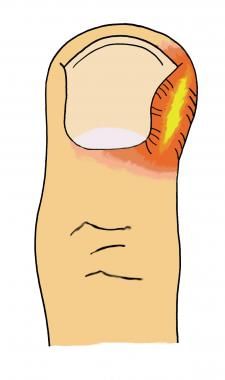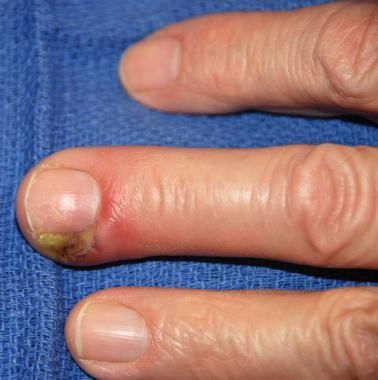Nail Bed Infection
Paronychia is a soft tissue infection around a fingernail that begins as cellulitis but that may progress to a definite abscess. The 2 types of paronychia are as follows :
-
Acute paronychia - Painful and purulent condition; most frequently caused by staphylococci.
-
Chronic paronychia - Usually caused by a fungal infection
The image below depicts paronychia.
Classic presentation of paronychia, with erythema and pus surrounding the nail bed.
Signs and symptoms
Physical findings in acute paronychia include the following:
-
The affected area often appears erythematous and swollen
-
In more advanced cases, pus may collect under the skin of the lateral fold
-
If untreated, the infection can extend into the eponychium, in which case it is called eponychia
Further extension of the infection can lead to the involvement of both lateral folds as it tracks under the nail sulcus; this progression is called a runaround infection.
Physical findings in chronic paronychia include the following:
-
Swollen, erythematous, and tender nail folds without fluctuance are characteristic of chronic paronychia
-
Eventually, the nail plates become thickened and discolored, with pronounced transverse ridges
-
The cuticles and nail folds may separate from the nail plate, forming a space for the invasion of various microorganisms
Diagnosis
The diagnosis of paronychia is based primarily on patient history and physical examination. Some laboratory studies, however, can be useful. These include the following:
-
Gram staining and/or culture - To help identify a bacterial cause of fluctuant paronychia.
-
Potassium hydroxide (KOH) 5% smears - To help diagnose fluctuant paronychia caused by a candidal infection
Management
Treatment strategies for paronychia include the following:
-
If soft tissue swelling is present without fluctuance, the infection may resolve with warm soaks 3-4 times daily
-
Patients with extensive surrounding cellulitis or with a history of diabetes, peripheral vascular disease, or an immunocompromised state may benefit from a short course of antibiotics
-
If an abscess has developed, incision and drainage must be performed.




+1.svg)
